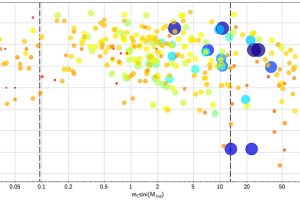Stellar chemical composition and planetary formation. The study “Connecting substellar and stellar formation. The role of the host star’s metallicity” of J. Maldonado (INAF-OAPA) recently appeared on A&A

To date, about 4000 exoplanets (planets orbiting around other stars) have been confirmed. Stars hosting planets and sub-stellar companions span a wide range of stellar parameters and even evolutionary phases. For this reason, several studies have been focused on the connection between stellar parameters and the possibility to host planets or sub-stellar companions such as brown dwarfs.
In particular, the study of the connection between stellar metallicity (which is the abundance of heavy elements such as iron over hydrogen) and the frequency of giant planets around stars, provides important insight on the planets formation mechanism. For instance, the core-accretion model (Pollack et al. 1996), which predicts that giant planets form by the accretion of gas from the surrounding environment on massive rocky cores, suggests that the efficiency of planetary formation increases with the metallicity of the circumstellar environment. At low metallicity, in fact, the time required for the formation of a massive rocky core is too long to allow the accretion of the amount of gas required for the formation of a gaseous giant planet. Several studies exists on this field, but they all focus on given products of the planetary formation process (such as giant planets, rocky planets, or brown dwarf separately) or given type of stars (such as giants and low mass main sequence dwarf).
The team led by the astronomer of INAF-Astronomical Observatory of Palermo J. Maldonado, counting the astronomer G. Micela of INAF-OAPA and astronomers of the Universidad Autónoma de Madrid, has analyzed in an homogeneous way a large sample of stars with sub-stellar companion spanning a wide range of stellar and companion properties (59 stars with a brown dwarf, 208 with giant planets, and 78 with low-mass planets), with the aim of studying the connection between the stellar metallicity and the type and frequency of sub-stellar companions. This is the first time that such an analysis is made in an homogeneous way over such a large sample of targets. This study, described in the paper “Connecting substellar and stellar formation. The role of the host star’s metallicity” recently appeared on Astronomy & Astrophysics, shows that the more massive the companion, the lower the metallicity of the host star, suggesting that massive companions likely formed with a different mechanism than the core-accretion model. This mechanism is efficient in forming Jupiter-like planets, with a mass between 0.2 and 2 Jupiter masses. Small rocky planets in low metallicity stars may also formed with the core-accretion mechanism, but more data are needed to confirm this possibility.
The image (link) shows a scatter plot of the metallicity of the stars in this sample over their mass and that of their sub-stellar companion. The vertical lines delimit the mass regimes of the sub-stellar companions.
